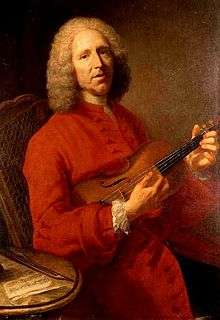Anacréon (Rameau, 1757)
| Jean-Philippe Rameau |
|---|
 |
|
Operas
See also: |
Anacréon is an opera by the French composer Jean-Philippe Rameau, first performed at the Opéra, Paris, on 31 May 1757 as part of a revised version of the opéra-ballet Les surprises de l'Amour. It takes the form of a one-act acte de ballet and has a libretto by Pierre-Joseph-Justin Bernard.[1] Rameau had written another opera with the same title in 1754. The earlier work has a libretto by Louis de Cahusac and a completely different plot. Both are linked by the figure of the ancient Greek lyric poet Anacreon. The second Anacréon was composed to be the third entrée of a revised version of Rameau's opéra-ballet Les surprises de l'Amour. The work had originally been staged in 1748 and when it came to be revived in 1757 the allegorical prologue, referring to the Treaty of Aix-la-Chapelle, was no longer relevant. This meant that the work now only contained two entrées so another act had to be written of roughly the same length as the prologue. The revised Les surprises de l'Amour was a great success. Anacréon was also performed as a separate work in 1769 and 1771, after Rameau's death.[2]
Roles
| Role | Voice type | Premiere Cast, May 31, 1757 (Conductor: - ) |
|---|---|---|
| Anacréon | bass-baritone | Nicolas Gélin |
| L'Amour | soprano | Marie-Jeanne Lemière |
| La Prêtresse de Bacchus | soprano | Mlle Davaux |
| Agathocle | haute-contre | François Poirier |
| Euricles | haute-contre | Monsieur Muguet |
Synopsis
The slight plot concerns an argument over the relative merits of wine, symbolised by Bacchus, and love. The Maenads, followers of Bacchus, claim the two are incompatible and threaten the poet Anacreon who holds the contrary view. The quarrel is resolved in Anacreon's favour by L'Amour (Cupid).[3]
Recordings
- Anacréon Les Arts Florissants, William Christie (1 CD, Harmonia Mundi, 1982)
- Anacréon Les Musiciens du Louvre, Marc Minkowski (1 CD, Deutsche Grammophon, 1996)
References
- Sources
- Girdlestone, Cuthbert, Jean-Philippe Rameau: His Life and Work, New York: Dover, 1969 (paperback edition)
- Holden, Amanda (Ed.), The New Penguin Opera Guide, New York: Penguin Putnam, 2001. ISBN 0-14-029312-4
- Labie, Jean-François, Booklet notes to the Christie recording
- Pitou, Spire, The Paris Opéra. An Encyclopedia of Operas, Ballets, Composers, and Performers – Rococo and Romantic, 1715-1815, Greenwood Press, Westport/London, 1985 (ISBN 0-313-24394-8)
- Sadler, Graham, (Ed.), The New Grove French Baroque Masters Grove/Macmillan, 1988
- Notes
- ↑ for the unabridged French libretto, see Rameau Le site, page: “Anacréon”.
- ↑ Booklet notes to the William Christie recording.
- ↑ For a more detailed synopsis cf. Les surprises de l'Amour: Anacréon.